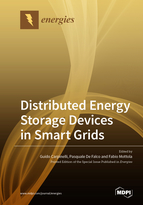Distributed Energy Storage Devices in Smart Grids
A special issue of Energies (ISSN 1996-1073). This special issue belongs to the section "A1: Smart Grids and Microgrids".
Deadline for manuscript submissions: closed (31 October 2019) | Viewed by 28767
Special Issue Editors
Interests: distributed energy storage devices; smart grids; forecasting; power quality issues
Interests: planning and operation of power systems; smart grids; optimal integration of distributed energy resources; renewable energy sources; energy storage systems
Interests: electrical power systems; electric vehicles; optimization models; data analysis; forecasting techniques
Special Issues, Collections and Topics in MDPI journals
Special Issue Information
Dear Colleagues,
Energy storage systems have been recognized as viable solutions for implementing the smart grid paradigm, providing features in load levelling, integrating renewable and intermittent sources, voltage and frequency regulation, grid resiliency, improving power quality and reliability, reducing energy import during peak demand periods, and so on. In particular, distributed-energy storage addresses a wide range of the above potential issues, and it is gaining specific attention from customers, utilities, and regulators.
The potential of distributed-energy storage in reducing costs and in improving the quality of electric services is considerable. However, installation costs and lifetime durations are the main drawbacks to the wide diffusion of this technology. In this context, a serious challenge to be faced is the adoption of new techniques and strategies for the optimal planning, control, and management of grids that include distributed-energy storage devices. Moreover, there is a significant need for regulatory guidance and proactive policies to ensure a smooth rollout of this technology.
Original and unpublished contributions discussing theoretical aspects and practical applications of distributed-energy storage systems in smart grids are invited to be submitted. Proposals can address new solutions for the planning and operation of smart grids equipped by distributed-energy storage devices. Review papers will also be taken in consideration for publication. Papers on research projects involving cooperation among researchers from academia, industries, and government will also be welcome to foster interactions among stakeholders.
Prof. Guido Carpinelli
Dr. Fabio Mottola
Dr. Pasquale De Falco
Guest Editors
Manuscript Submission Information
Manuscripts should be submitted online at www.mdpi.com by registering and logging in to this website. Once you are registered, click here to go to the submission form. Manuscripts can be submitted until the deadline. All submissions that pass pre-check are peer-reviewed. Accepted papers will be published continuously in the journal (as soon as accepted) and will be listed together on the special issue website. Research articles, review articles as well as short communications are invited. For planned papers, a title and short abstract (about 100 words) can be sent to the Editorial Office for announcement on this website.
Submitted manuscripts should not have been published previously, nor be under consideration for publication elsewhere (except conference proceedings papers). All manuscripts are thoroughly refereed through a single-blind peer-review process. A guide for authors and other relevant information for submission of manuscripts is available on the Instructions for Authors page. Energies is an international peer-reviewed open access semimonthly journal published by MDPI.
Please visit the Instructions for Authors page before submitting a manuscript. The Article Processing Charge (APC) for publication in this open access journal is 2600 CHF (Swiss Francs). Submitted papers should be well formatted and use good English. Authors may use MDPI's English editing service prior to publication or during author revisions.
Keywords
- analysis of cost and benefits of distributed energy storage devices
- cycle life and calendar life for storage devices connected to smart grids
- costs and benefits of customer-owned storage systems to achieve specific types of grid benefits
- optimal sizing and siting of distributed energy storage devices
- distributed-energy storage devices and power quality and/or reliability improvement
- optimal control and management of smart grids that include distributed energy storage devices
- DC networks modeling in the presence of distributed-energy storage devices
- hybrid AC-DC networks modeling in the presence of distributed-energy storage devices
- renewable-energy bidding strategies considering the integration of storage devices
- increasing renewable-energy penetration considering distributed-energy storage devices
- optimal planning and control of smart grids considering an increased penetration of plug-in (hybrid) electric vehicles
- forecasting loads and renewable generation for integration with distributed-energy storage systems
- policy and regulation for distributed energy storage device development
- real-world practical applications of distributed-energy storage devices








